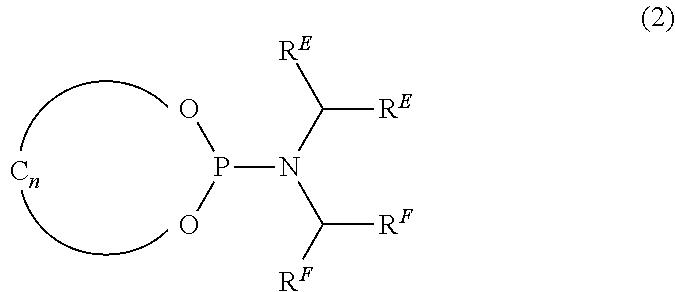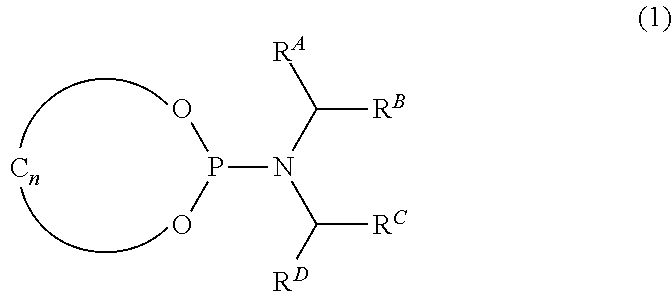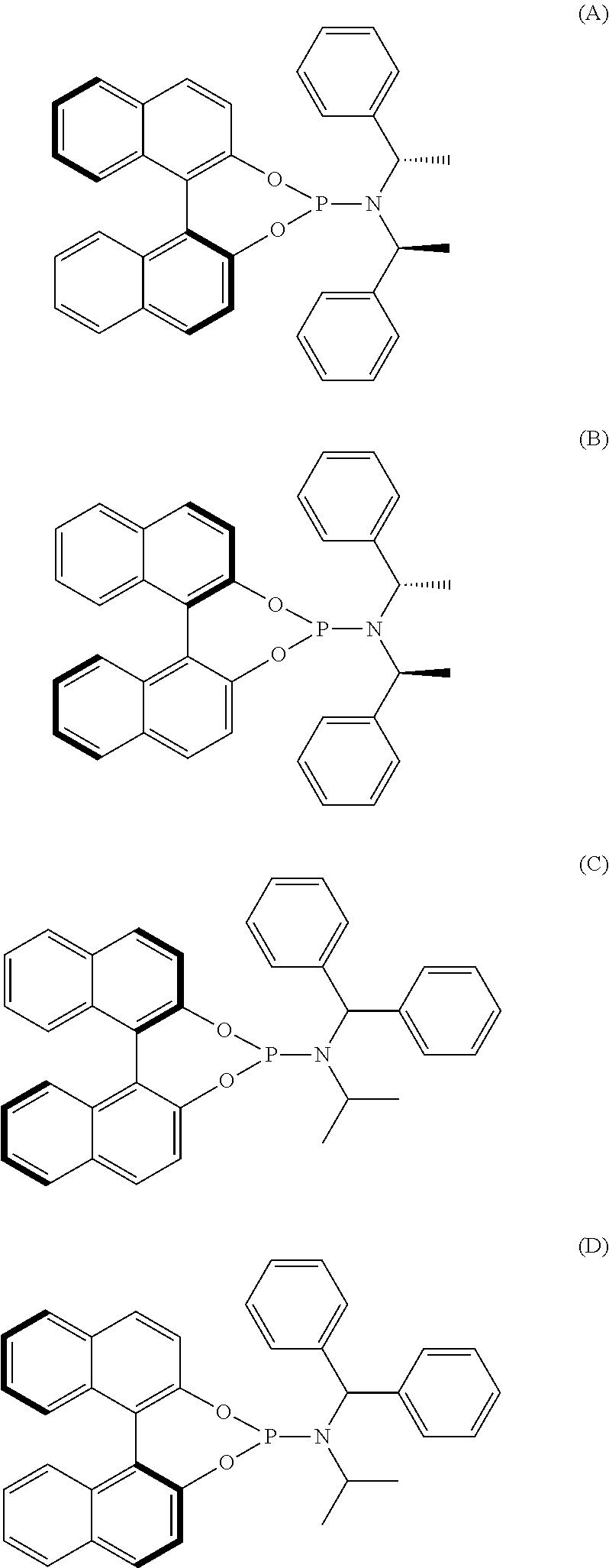Catalysts, ligands and use thereof
a technology of ligands and catalysts, applied in the field of catalysts, can solve the problems of fewer catalytic asymmetric methods for forming carbon-carbon bonds, fewer reagents, and fewer catalytic asymmetric methods, etc., and achieves enhanced stereoselectivity, high enantiomeric excess, and increased stereoisomeric excess in asymmetric reactions.
- Summary
- Abstract
- Description
- Claims
- Application Information
AI Technical Summary
Benefits of technology
Problems solved by technology
Method used
Image
Examples
example 1
N-Benzhydrylpropan-2-amine
[0237]
[0238]Acetone (1.9 mL, 2.58 mmol, 2.00 eq) was added to a stirring solution of diphenylmethanamine (2.26 mL, 12.9 mmol, 1 eq) in THF (100 mL) at room temperature. After 5 minutes, NaB(OAc)3H (4.10 g, 19.4 mmol, 1.5 eq) was added. The resulting suspension was stirred for 48 hours. Et2O (50 mL) and NaHCO3 (aq. sat., ca. 50 mL) were added to the suspension which was stirred for an extra 15 minutes. The mixture was partitioned between the aqueous and Et2O layers and the aqueous phase extracted with Et2O (3×30 mL). The combined organic phase was concentrated in vacuo to one third of its volume (˜20 mL). Then HCl (aq 2.0 M, 25 mL) was added dropwise. The mixture was partitioned between the aqueous and Et2O layers and the organic phase extracted with HCl (aq 2.0 M, 25 mL). Then CH2Cl2 (20 mL) was added to the combined aqueous phases and NaOH (aq, 25%) was added until the mixture became basic (pH paper, pH ˜14). The mixture was partitioned between the aqueous...
example 2
N-Benzhydryl-N-isopropyldinaphtho[2,1-d:1′,2′-f][1,3,2]dioxa-phosphepin-4-amine (ligand C)
[0239]
[0240]Triethylamine (4.6 mL, 33.3 mmol, 5.00 eq) was added dropwise to an ice -cooled solution of PCl3 (0.58 mL, 6.66 mmol, 1.00 eq) in CH2Cl2 (40 mL). The ice bath was removed and the solution left to warm to room temperature before N-benzhydrylpropan-2-amine (1.5 g, 6.33 mmol, 1.00 eq) was added to the stirring solution. (R)-Binaphthol was added to the suspension after 5 hours and the subsequent mixture was left stirring overnight. The solution was then filtered on a small pad of silica and Celite® and washed with CH2Cl2. After removing the solvent in vacuo, flash column chromatography of the yellow residue (78:17:1: Petrol: CH2Cl2 / Et3N; SiO2) gave phosphoramidite ligand C (2.61 g, 4.8 mmol, 73%) as a white solid. 1H NMR (500 MHz, CDCl3) δH / ppm 1.06 (d, J=6.6 Hz, 3 H), 1.18 (d, J=6.1 Hz, 3 H), 3.68 (dq, J=11.8, 6.1 Hz, 1 H), 5.80 (d, J=17.0 Hz, 1 H), 7.23-7.28 (m, 1 H), 7.28-7.46 (m, 11...
example 3
Triflimide Complex Containing Ligand C
[0241]
[0242]To a flame dried Schlenk flask, at room temperature under an argon atmosphere was added CuCl (46 mg, 0.47 mmol, 1 eq.) and ligand C (253 mg, 0.47 mmol, 1.0 eq.) followed by CH2Cl2 (10 mL). This mixture was stirred for 1 h before AgNTf2 (200 mg, 0.52 mmol, 1.1 eq) was added to the clear solution and stirred for a further 20 min. On the addition of the AgNTf2 the solution turns grey and a precipitate is formed (AgCl). The resulting solution was cannula filtrated into another Schlenk flask. The solvent was then gently removed by use of an oil-pump vacuum (with liquid nitrogen trapping). The resulting off-white solid was dried for at least one extra hour under oil-pump vacuum before storing the catalyst complex under argon. 1H NMR (400 MHz, C6D6) δH / ppm 7.86 (d, J=8.8 Hz, 1 H), 7.71 (d, J=8.8 Hz, 1 H), 7.52-7.65 (m, 3 H), 7.28-7.45 (m, 9 H), 7.24 (d, J=8.5 Hz, 2 H), 7.17-7.22 (m, 2 H), 7.02-7.12 (m, 2 H), 6.85 (dt, J=23.0, 8.0 Hz, 2 H), ...
PUM
 Login to View More
Login to View More Abstract
Description
Claims
Application Information
 Login to View More
Login to View More - R&D
- Intellectual Property
- Life Sciences
- Materials
- Tech Scout
- Unparalleled Data Quality
- Higher Quality Content
- 60% Fewer Hallucinations
Browse by: Latest US Patents, China's latest patents, Technical Efficacy Thesaurus, Application Domain, Technology Topic, Popular Technical Reports.
© 2025 PatSnap. All rights reserved.Legal|Privacy policy|Modern Slavery Act Transparency Statement|Sitemap|About US| Contact US: help@patsnap.com



